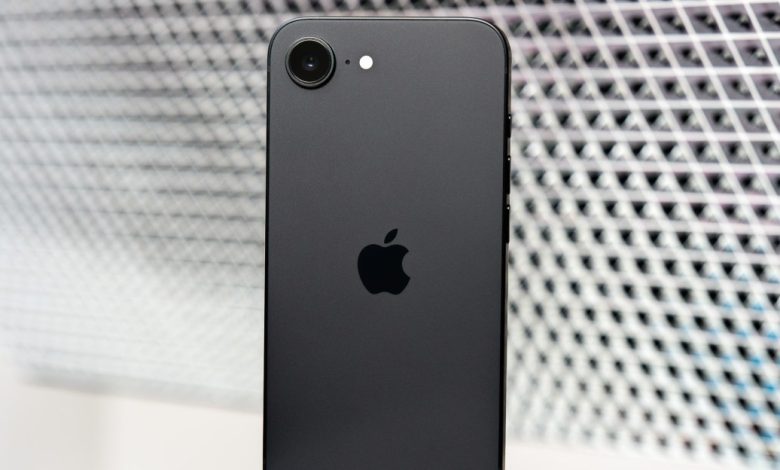iPhone 16E review: Eh, it’s alright

The iPhone 16E is everything I love and hate about iOS. FaceTime at your fingertips. A reliable camera. Simplicity. Familiarity. They’re the pillars of the iPhone experience, and Apple’s newest phone has ‘em.
My husband picked up the 16E, concerned that he would have to “learn something new” to use it. He swiped around for a second and said, “Oh. It’s just like my phone.” It is just like his phone — a six-year-old iPhone XR — only updated with a few essential improvements (a faster processor, nicer screen, and a modern camera, that kind of thing) and little else.
That’s the other pillar of the iPhone experience: You get exactly what Apple gives you and nothing more. On Android, you can buy a $500 phone with a fast refresh-rate screen, two rear cameras, seven years of software support, and wireless charging. On iOS, you can buy this $599 phone with one rear camera, a standard 60Hz screen, wireless charging (but no MagSafe), and an ample but unstated amount of software support. Apple has no competition when it comes to phones running iOS. The company can gatekeep these conveniences behind a higher price tag, and that’s simply the way things will be. I’m looking at you, ProMotion.
This is the world the iPhone 16E enters. It’s Apple’s cheapest phone, but it’s not cheap — probably for the aforementioned “lack of competition” reasons. It’s an iPhone that does iPhone things, but it’s probably missing at least one major feature for any given buyer, whether that’s an extra camera or the convenience of a MagSafe ring. If you’re clinging desperately to an older model and want a new iPhone for the least possible money, the 16E is the one to get.
That’s the job of the 16E: be the path of least resistance to blue bubbles. But for a more discerning customer the answer’s not as clear-cut.
The iPhone 16E is the spiritual successor to the iPhone SE, though Apple would rather you not think of it that way. The SE was the company’s budget-friendly line, a kind of close-out bargain bin offer on last generation’s chassis with upgraded internals. The design was wildly outdated by the end, but, hey, it only cost $429. That line appears to have ended with the 16E, which is fully a member of the iPhone 16 series.
Instead of an older design that’s a really good deal, we have a modern design that’s only kind of a deal
But instead of an older design that’s a really good deal, we have a modern design that’s only kind of a deal. It’s $200 cheaper than the $799 iPhone 16 and has a similar 6.1-inch OLED screen. There’s no Dynamic Island — just a notch. And instead of two rear lenses, you get just one: a 48-megapixel main camera and no ultrawide to go with it. You get wired charging, but no MagSafe. The Action Button, but no Camera Control. This, not that. And so on.
There’s a kind of equation that can help determine how much you should care about this list of missing features. How old is your current phone? Do other people in your household use MagSafe accessories that you want to share? Do you even know what MagSafe is? Would you like to follow sports scores at the top of your screen while you do other things on your phone, or are you a Seattle Mariners fan? (Love hurts, guys.) I don’t know what that exact formula is because I barely scraped by in calculus, but just bear it in mind as you read the rest of this review.
The 16E’s screen is very likely a version of the iPhone 14’s screen, complete with a notch housing the Face ID and front-facing camera array. The regular 16’s screen gets just a little brighter in theory, but in practice they look about the same to me, brightness-wise. The 16E’s screen doesn’t go down to one nit like the 16’s can, which is too bad because it’s honestly cool as hell and handy when you’re trying not to wake up your spouse with a bright phone screen. The notch’s existence also means no Dynamic Island — that’s the pill-shaped cutout Apple introduced with the iPhone 14 Pro, which houses tiny bits of timely info you might want to see at a glance.
All that time-sensitive information, like live sports scores and the proximity of your incoming Uber, is still presented on the 16E’s lock screen. But the Dynamic Island keeps it at the top of your screen while you do other things on your phone. It’s handy, and having gotten used to it, I missed it on the 16E. The extra visual confirmation is nice when you have a timer or screen recording in progress. The Dynamic Island probably won’t be a great loss if you’re used to a phone without it, though.
MagSafe might be another case of “if you’ve never had it then you won’t miss it,” but I’m a little less inclined to shrug off its absence on the 16E. Sure, there’s still Qi wireless charging. And you can always use a case with magnets as a workaround if you want to use MagSafe accessories, even if it’s not an elegant solution. But the beauty of MagSafe is the simplicity, and if you’re a case-hater like me then it’s a handy way to add a Pop Socket or a low-profile wallet to your phone without committing to a case. Aside from the SE, every iPhone from the 12-series onward has MagSafe. It feels like a standard feature now, and it’s hard to understand why Apple left it out.
The iPhone 16E’s rear camera uses a 48-megapixel sensor that combines pixels to help it better gather light, and it delivers nice images in most situations. There’s no ultrawide camera and therefore no macro photography either. I missed the ultrawide more than once when stepping backward to frame a wide shot wasn’t possible. There’s a decent portrait mode, though it’s the older version where you can’t change the focus point after the fact. Photographic Styles are available to help dial in color reproduction, though they’re also the previous-gen version and you can’t tweak undertones.
This is a camera system most people will be perfectly happy with. If you’re the least bit inclined photographically and want more flexibility — both in focal range and processing options — then consider an iPhone 16 or 16 Pro. But it’s a good camera for a general audience. There’s excellent 4K video recording, optical image stabilization, and reliable color reproduction. A more advanced phone camera would offer better chances of capturing moving subjects in dim light, but this one keeps up in most situations.
Much of the 16E is familiar, but there is one entirely new component: Apple’s C1 modem. This is its debut appearance, and the road to Apple’s first in-house modem was reportedly full of setbacks and delays. I’ve used it for the past week to make FaceTime calls, upload large video files in crowded places, and stream YouTube on the bus. I tested it alongside a regular iPhone 16 equipped with a Qualcomm-made modem — both on Verizon — and I didn’t see any consistent difference in performance between the two.
Every time I thought the iPhone 16 was faring better with video call quality or upload speeds, I’d try the same test again and the 16E would come out ahead. If I were none the wiser, I wouldn’t have given the modem a second thought as I used the phone. Given the difficulty Apple seemingly encountered building this thing and the complexity of a cellular modem, “it seems fine” is actually a great outcome for the C1.
Apple claims switching to its own modem has allowed it to squeeze a little more battery life out of the 16E, offering “the best battery life ever on a 6.1-inch iPhone,” according to its press release. Battery life certainly seems good. I spent an afternoon out of the house using a lot of navigation, streaming a podcast, testing connectivity, and watching YouTube. I clocked about five hours of screen time and was only down to 41 percent by the end of the day. I’m confident that most people could get through a day comfortably on this battery, but that’s not my biggest concern. I’m more curious about long-term battery health — Apple’s recent track record here is spotty — and there’s just no way of knowing that after a week of testing.
The other upgrade here is Apple Intelligence. Maybe you’ve heard of it? Or seen it on a billboard? Or in a commercial a few dozen times? Apple would like us to think of its AI as a marquee feature on the 16E, but Apple Intelligence just doesn’t feel like one — not yet, anyway. But it’s all here: the AI writing tools, Image Playground, notification summaries, and the updated Siri with a ChatGPT extension. It’s all pretty forgettable right now.
Case in point: it took me several days to notice that Apple Intelligence wasn’t running on the 16E I was testing, despite having the Apple Intelligence option turned on. I sorted it out — I guess something about the way I set it up prevented the necessary AI models from downloading — but this says a lot about how useful Apple Intelligence is right now. The most interesting stuff is yet to come, and the 16E will be ready for it, which is nice. But I definitely wouldn’t let Apple Intelligence be a deciding factor in picking this phone versus, say, an iPhone 15.
That highlights where I’m stuck trying to figure out the 16E. If you’re coming from an older iPhone like an 11, don’t want to spend a lot, and don’t care about MagSafe or an ultrawide camera, then the 16E kind of makes sense. But a hundred dollars more will get you a new iPhone 15 with MagSafe, the Dynamic Island, and an ultrawide camera, though there’s no Apple Intelligence or action button.
The 16E feels like it should offer the essentials, but it’s hard to say what’s an essential iPhone feature and what’s not. It’s probably more like a combination of features, and for some people, the 16E likely offers a combination they’ll be happy with. Specifically, I mean people like my husband and anyone else with an old iPhone who is uninterested in learning what MagSafe is, rarely takes pictures, and just wants a dang iPhone. The 16E covers those essentials. For someone who wants more flexibility from their smartphone’s camera or its system of accessories, this isn’t the iPhone for you.
I’d rather have a cool magnetic accessory system and a neat quick-glance display feature built into my phone than Apple Intelligence, especially for $600. It doesn’t quite add up for me, but maybe the math looks a little different for you.
Agree to continue: Apple iPhone 16E, 16, 16 Plus, 16 Pro, and 16 Pro Max
Every smart device now requires you to agree to a series of terms and conditions before you can use it — contracts that no one actually reads. It’s impossible for us to read and analyze every single one of these agreements. But we’re going to start counting exactly how many times you have to hit “agree” to use devices when we review them since these are agreements most people don’t read and definitely can’t negotiate.
To use any of the iPhone 16 models, you have to agree to:
- The iOS terms and conditions, which you can have sent to you by email
- Apple’s warranty agreement, which you can have sent to you by email
These agreements are nonnegotiable, and you can’t use the phone at all if you don’t agree to them.
The iPhone also prompts you to set up Apple Cash and Apple Pay at setup, which further means you have to agree to:
- The Apple Cash agreement, which specifies that services are actually provided by Green Dot Bank and Apple Payments Inc. and further consists of the following agreements:
- The Apple Cash terms and conditions
- The electronic communications agreement
- The Green Dot Bank privacy policy
- Direct payments terms and conditions
- Direct payments privacy notice
- Apple Payments Inc. license
If you add a credit card to Apple Pay, you have to agree to:
- The terms from your credit card provider, which do not have an option to be emailed
Final tally: two mandatory agreements, seven optional agreements for Apple Cash, and one optional agreement for Apple Pay.










